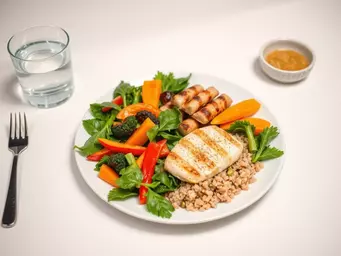Targeted Therapy vs. Traditional Chemotherapy
By Dr. Elise Carter / Nov 21
When facing a chemotherapy treatment plan, understanding the components of your regimen can empower you to make informed decisions about your health. Vinca alkaloids and taxanes are critical players in this arena, each with unique properties and mechanisms that affect treatment outcomes.
Delve into the distinct ways vinca alkaloids and taxanes combat cancer, and explore their specific uses in treatment.
Origin: Periwinkle plant.
Origin: Pacific yew tree bark.
When it comes to chemotherapy, it's fascinating to explore the plant alkaloids that play significant roles in treating cancer. Two prominent classes of these alkaloids are vinca alkaloids and taxanes. These compounds, derived from plants, have unique properties that contribute to their effectiveness in cancer treatment. Vinca alkaloids originate from the periwinkle plant, while taxanes are derived from the bark of the Pacific yew tree. Understanding these origins can help demystify the science behind their use in oncology. For further reading, you can explore detailed information on plant alkaloids and terpenoids in chemotherapy.
Vinca alkaloids, such as vincristine and vinblastine, are essential components in chemotherapy regimens. They work by disrupting the ability of cancer cells to divide. On the other hand, taxanes, like paclitaxel and docetaxel, also target cell division but do so through a different mechanism. The unique characteristics of these alkaloids allow oncologists to tailor treatments based on the specific needs of patients.
Both classes are valuable in the fight against cancer, and understanding them is crucial for patients navigating their treatment options. Have you ever considered how these natural compounds are harnessed to combat such a formidable disease?
The mechanisms of action for both vinca alkaloids and taxanes focus on microtubule dynamics. Vinca alkaloids inhibit the assembly of microtubules, which are necessary for cell division. As a result, cancer cells cannot complete the process of mitosis, leading to cell death. In contrast, taxanes stabilize existing microtubules, preventing them from disassembling and effectively freezing the cell cycle. For a deeper understanding of how these drugs interact with cells, you might find this article on natural anticancer drugs and their mechanisms insightful.
This contrasting approach is essential for oncologists in designing effective chemotherapy regimens. Have you experienced feeling overwhelmed by this information? Knowing how different treatments work can empower you to make informed decisions about your care.
Two critical vinca alkaloids, vincristine and vinblastine, have distinct properties that influence their use in treatment. Vincristine is typically used for leukemias and lymphomas, while vinblastine is more commonly used for solid tumors and certain testicular cancers. Each alkaloid comes with specific dosing regimens and potential side effects that oncologists carefully consider.
Understanding these differences can be vital for patients as they discuss their treatment options with healthcare providers. Reflecting on your journey, can you see how knowing these specifics might guide your conversations with your oncologist?
Moving on to taxanes, both paclitaxel and docetaxel play essential roles in managing various cancers. Paclitaxel is widely used for breast and ovarian cancers, while docetaxel is often reserved for lung and prostate cancers. Their mechanism of action—stabilizing microtubules—means that they can effectively halt cancer cell division, leading to successful treatment outcomes. To learn more about the broader impact of natural products in cancer treatment, consider exploring this resource on the role of natural products in cancer drug development.
The choice between these taxanes depends on the type of cancer being treated and the individual patient's health profile. As you navigate your own treatment options, how do you feel about discussing these specific drugs with your doctor?
As we delve deeper into the impact of plant alkaloids in chemotherapy, we want to know your thoughts! How do you feel about the use of natural compounds in cancer treatment? Share your opinion below:
Throughout this article, we’ve explored the fascinating world of vinca alkaloids and taxanes in chemotherapy. These two classes of plant alkaloids play a pivotal role in cancer treatment, each with unique mechanisms of action that target cancer cells effectively. Understanding these differences is crucial for patients and caregivers navigating their treatment options.
We discussed how vinca alkaloids like vincristine and vinblastine disrupt the microtubule dynamics essential for cell division, while taxanes such as paclitaxel and docetaxel stabilize microtubules, preventing cell division. This fundamental difference in action highlights why these drugs are often used in combination therapies, enhancing their effectiveness against various cancer types.
Our journey through these alkaloids has equipped you with knowledge about their applications, side effects, and the challenges associated with drug resistance. By understanding these aspects, you can feel more empowered in discussions with your healthcare team and make informed decisions about your treatment path.
As you reflect on the information presented, I encourage you to seek further insights on chemotherapy, particularly regarding vinca alkaloids and taxanes. Engaging with credible sources such as Types of Chemotherapy can help demystify these treatments. Remember, knowledge is power, especially when it comes to making informed decisions about your health!
Don’t hesitate to reach out to your healthcare professionals with any questions or concerns you may have about your treatment options. They are there to support you and can provide personalized advice tailored to your unique situation. Have you thought about what questions you’d like to ask during your next appointment? Jotting them down can create a productive dialogue that enhances your understanding and comfort with your treatment journey.
Here is a quick recap of the important points discussed in the article:

 Targeted Therapy vs. Traditional Chemotherapy
Have you considered how understanding cancer treatments can empower your journey? Knowledge not only
Targeted Therapy vs. Traditional Chemotherapy
Have you considered how understanding cancer treatments can empower your journey? Knowledge not only
 Nutrition Strategies for Chemotherapy Patients
Nutrition plays a critical role in supporting your body during chemotherapy. By making informed diet
Nutrition Strategies for Chemotherapy Patients
Nutrition plays a critical role in supporting your body during chemotherapy. By making informed diet
 Preparing for Your First Chemotherapy
Have you ever felt overwhelmed at the thought of a major medical treatment? The uncertainty and anxi
Preparing for Your First Chemotherapy
Have you ever felt overwhelmed at the thought of a major medical treatment? The uncertainty and anxi